Early learning and childcare - parents' views and use: survey findings 2022
Findings from a survey undertaken to explore use of, and views on, early learning and childcare (ELC) services among parents and other primary carers of children in Scotland who have not yet started school.
Research findings
Use of early learning and childcare
This section starts by profiling childcare use for all children in the sample who have not yet started school (referred to for ease in this report as 'pre-school children'), considering the type of childcare used and the level of childcare used. It then considers use of funded ELC and explores the extent to which parents are using their full entitlement and the reasons for their choices. The next section goes on to explore the numbers of hours of funded ELC used in more detail.
Use of childcare
Most of the parents (98%) use some form of childcare for their pre-school children. As shown in Table 3 below, propensity to use childcare increases with a child's age, rising from 67% of under two year olds to just under 100% of three to five year olds.
Q:SQ3 – Which of the following types of childcare and early learning do you use for your children?[18] Bases All 8,181; under 2s 2,006; 2s, 1535; 3-5 6,875 (respondents could answer in more than one category)
| All |
3-5 year olds |
2 year olds |
Under 2s |
|
|---|---|---|---|---|
| Funded early learning and childcare[19] |
82% |
94% |
19% |
4% |
| Childcare or early learning that I pay for myself |
36% |
22% |
60% |
41% |
| Informal childcare: regular or frequent |
29% |
25% |
32% |
30% |
| Informal childcare: occasional or infrequent |
12% |
10% |
10% |
15% |
| Total using childcare |
98% |
99% |
89% |
67% |
| Total not using childcare |
2% |
1% |
11% |
33% |
The type(s) of childcare used also varies by the child's age. The three to five year olds in the sample were almost all entitled to funded ELC, so we would expect to see a high proportion of this group using this provision. In addition, around a fifth were using paid-for provision (typically in addition to the funded ELC). In contrast, a much smaller proportion of two year olds were entitled to funded ELC so usage was much lower for this age-group. More than half of two year olds are in paid-for provision. Four per cent of the parents of under two year olds said they were using funded ELC[20].
There was variation in the use of childcare for three to five year olds linked to the household structure – most notably the number of parents in work. Propensity to use paid-for childcare and regular/occasional informal childcare increased as the number of parents in work increased, as incomes rose, and to some extent, with the age of the parent (up to age 40)[21].Table 3 shows the profile of childcare use by age group of the child. This allows us to develop a better understanding of how parents use childcare. As detailed below, those with greater resources (higher incomes, greater access to employment) make more use of all forms of childcare, especially paid-for childcare, but notably also informal childcare and, for three to five year olds, funded ELC. Those with lower resources make less use of paid-for childcare; and for younger age-groups, may not use childcare at all.
Use of childcare for under two year olds
Thirty-three per cent of parents with a child under two years old do not use any childcare. The number of working parents in the household is a key influencing factor in whether parents use childcare: just 28% of households with no parents in work use some form of childcare, compared to 46% of those with one working parent and 78% of those with two working parents. Likewise, use of childcare rises as household income rises, with just 46% of those earning less than £16,000 using childcare, rising to 78% for those earning over £60,000.
Similar proportions - around a fifth - of parents use informal childcare, paid childcare or a mix of both. Typically, two parent families, households with two working parents and those on higher incomes are more likely to use both paid and informal childcare.
The number of pre-school age children in the household influences the mix of childcare for children under two. As illustrated in the chart below, those who have a single child aged under two are more likely than others to use paid forms of childcare, while parents who also have a child(ren) aged three to five years are more likely than others to either use informal care or not use any childcare for their under two.
Figure 1: Use of childcare for children aged under two, by age profile of children in the household
Bases: Just children 0-2 yrs = 581; Both 0-2 and 3-5 yrs=1425
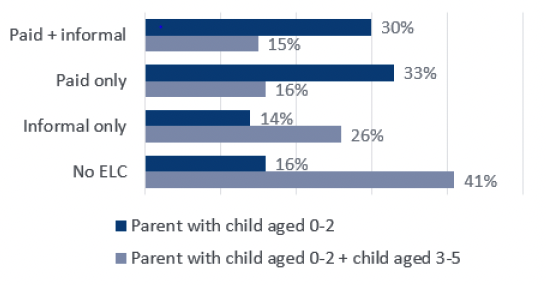
Use of childcare for two year olds
Eleven per cent of parents with a two year old do not use any childcare. As noted above, well over half of parents of two year olds use paid-for childcare: around a third use paid-for care only, with a further quarter using a mix of paid-for and informal care. Sixteen per cent use funded ELC only and a further 2% use a mix of funded and informal. Those more likely to say they use paid-for care were households with one child, two parent households, households with two parents in work, households on higher incomes (£30,000+) and those living in non-deprived areas.
Notably only a handful of parents use a mix of funded and paid-for care, which is perhaps not unexpected, given the eligibility criteria for two year olds' funded ELC. Similarly, those more likely to use funded ELC are those in the less advantaged sub-groups i.e. single parents, households with no-one/one parent in work, low income households, under 25s, and those living in deprived areas. This was also the case for parents of a child with Additional Support Needs (ASN).
Three to five year olds
Just 1% of parents do not use any childcare for their three to five year old pre-school children, with over half (53%) only using funded ELC and a further 23% using a mix of funded and informal. That means the vast majority of parents do not bear direct costs for their childcare (they may still have costs associated with trips, travel, etc.). Those most likely to be using only funded ELC were households in the less advantaged group: single parents, households with no-one or just one parent in work; low income households (earning under £16,000); living in a deprived area; as well as those with English as a second or additional language, those with health conditions, and parents of a child with ASN.
Q:SQ3 – Which of the following types of childcare and early learning to you use for your children?[22] Bases: under 2 yrs 2,006; 2 yrs, 1535; 3-5 yrs 6,875 (respondents could answer in more than one category)
| 3-5 yrs |
2 yrs |
0-1 yrs |
|
|---|---|---|---|
| Funded only |
53% |
16% |
2% |
| Funded + informal |
23% |
2% |
1% |
| Funded + paid |
10% |
1% |
0% |
| Funded + paid + informal |
9% |
1% |
0% |
| Paid only |
2% |
31% |
21% |
| Paid + informal |
1% |
27% |
20% |
| Informal only |
1% |
11% |
22% |
| No childcare |
1% |
11% |
33% |
Levels of childcare use
Of those using paid-for childcare, the average number of hours used per week during term time was similar across all child age groups - at around 20 hours per week. Use of paid-for childcare was slightly lower during school holidays, especially so for those with children aged three and over. Informal childcare was more common for younger children (under threes) especially during term time.
Q:SQ4 and SQ5 – You said that you [pay for some childcare for one or more of your children yourself/that one or more of your children receive informal childcare on an informal or regular basis.] On a typical week, on average how many hours of [paid-for/informal] childcare do your children receive? Bases (all those paying for childcare/using informal childcare) 0-1 yrs 808/872; 2 yrs 923/644; 3-5 yrs 1477/2280
| 3-5 yrs |
2 yrs |
0-1 yrs |
|
|---|---|---|---|
| Paid-for childcare |
|||
| Term time |
20.1 |
20.4 |
21.5 |
| School holidays |
17.0 |
18.0 |
19.0 |
| Informal childcare |
|||
| Term time |
12.0 |
15.1 |
15.7 |
| School holidays |
15.1 |
13.1 |
12.7 |
Some differences were noted in the profile of use within each of the age groups[23].
Under twos
- households with two working parents used more paid-for childcare hours than other households in term time (22.1 vs 6.9 hours)
- the amount of paid-for childcare used increases with income (from an average of 13.7 hours for households with incomes up to £16,000 pa rising to 25.4 hours for those with incomes of £60,000+ pa)
- the amount of paid-for childcare used was higher in large urban areas than most other areas (23.5 vs 15.2 - 20 hours)
- use of informal childcare was also higher in households with two working parents and in urban areas
Two year olds
- two-parent families used more informal childcare than lone parents during term-time (15.4 vs 12.2 hours), as did parents without a significant health condition compared to those with a health condition (15.6 vs 7.1 hours)
- households with two parents in work used more hours than those with one parent in work both in term time (15.7 vs 11.9 hours) and during school holidays (13.5 vs 10.6 hours)
Three to five year olds
- households with a child with ASN used more paid-for childcare hours than others (20.5 vs 16 hours)
- those without a health condition used more paid-for childcare than others during term-time (20 vs 15 hours)
- parents in urban areas used more paid-for childcare than those in rural areas (21.6 vs 14.0 hours during term time)
- use of informal childcare was higher in urban than in rural areas (12.5 vs 9.7 hours in term-time); for lone parents versus two parent households (19.8 vs 14.6 hours during the school holidays); and for parents who have one child compared with parents with more than one child (both during term-time 12.9 vs 9.9 hours and during holidays 16.3 vs 11.5 hours)
Use of funded ELC
Most of the survey focused on use and views relating to funded ELC. Almost all (97%) of the parents with a three to five year old child and most (86%) with an eligible two year old[24] have used funded ELC for their child since August 2021. Given the eligibility criteria for two year olds, it is perhaps not surprising that the following subgroups of parents with two year olds are more likely to use funded ELC: single versus two parent households (93% vs 76%), households with no or one parent in work versus those with two (89% and 88% vs 70%); those living in most deprived areas versus others (92% vs 79%); and parents with a health condition versus others (95% vs 79%). There were no significant subgroup differences for three to five year olds.
Figure 2 below summarises why parents use funded ELC, with benefits to their child's development, confidence/independence and learning the most frequently mentioned reasons by parents regardless of their child's age. Parents of older children were significantly more likely than those with younger children to cite work/looking for work as a reason for using their funded ELC hours, while parents of younger children were more likely to mention having more time to look after themselves.
A number of other sub-group differences were observed. Most related to the three to five year olds group:
- those more likely to mention reasons relating to improving work opportunities were:
- households with two parents in work compared to those with one or no parents in work (84% vs 62% and 40%)
- parents with one child under six years versus two or more children under six years (76% vs 70%)
- two parent households compared to single parents (76% vs 67%); parents without health conditions compared to those who have significant conditions (77% vs 41%)
- those from non-deprived areas compared to deprived areas (77% vs 65%)
- parents of children without ASN compared to those with ASN (76% vs 63%)
- those more likely to mention reasons relating to benefits to their child were parents with significant health conditions compared with those without (97% vs 90%) and parents of a child with ASN compared to others (95% vs 90%)
Far fewer significant differences were observed for the eligible two year old group. Those more likely to mention reasons relating to improving work opportunities were households with one or two parents in work compared with no parents in work (61% and 68% vs 24%); and parents of children without ASN compared to those with ASN (53% vs 33%).
Figure 2: Main reasons for using funded ELC
Q9 and Q23 What are/were your main reasons for using funded early learning and childcare (for your 2 year old child)? Bases (all eligible): 3-5 years 6698, Eligible 2s 227
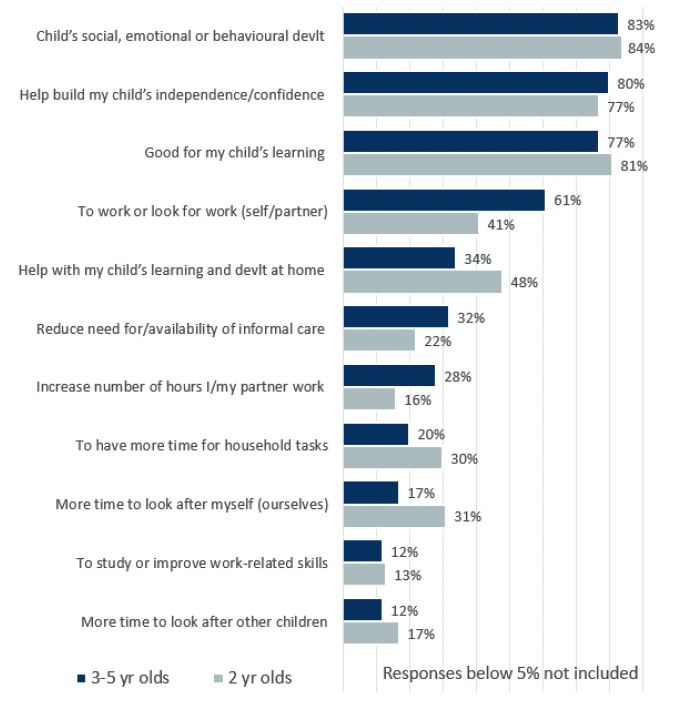
Nets: 3-5 year olds[25]
- reasons that benefit child: 91%
- improve work opportunities: 74%
- support home, personal and childcare: 51%
Nets: eligible 2 year olds
- reasons that benefit child: 94%
- improve work opportunities: 46%
- support home, personal and childcare: 57%
* Respondents could give multiple answers. Parents of 3-5 year olds tended to give 4 or 5 responses (21%/21%). Parents of eligible 2s also tended to give 4 or 5 responses (21%/17%).
As noted above, since August 2021, all eligible children have been entitled to 1,140 hours of funded ELC. Parents were asked if they used their full entitlement. Table 6 shows that around three-quarters of parents with a three to five year old and around half of those with a two year old used the full entitlement. Notably almost a tenth of those with three to five year olds and around a fifth of those with a two year old said they were unsure. Households with more than one earner were more likely than others (76% vs 69%) to use their full entitlement, as were those on higher incomes (£60,000+) compared to those on lower incomes (less than £16,000) (79% vs 68%). Parents from deprived areas were more likely than others to say they do not use their full entitlement (15% vs 20%).
Q4 and Q17 – Do/did you use the full 1140 hours of funded childcare for your child?
Bases 3-5s 6698; Eligible 2s 227
| 3-5 year olds |
Eligible 2 year olds |
|
|---|---|---|
| Full entitlement used |
73% |
52% |
| Full entitlement not used |
19% |
27% |
| Don't know[26] |
8% |
21% |
| Base |
6,698 |
227 |
Most of those not using their full entitlement reported they were doing so through choice: typically, they did not need or want the full entitlement or did not want their child in nursery for so many hours. However, around a quarter (23%) mentioned that they could not get the sessions that they wanted at their preferred setting. This was a particular issue for households with two parents in work compared with a single earner (24% vs 19%); where English is an additional language compared with other households (27% vs 22%); and in urban areas compared with rural areas (24% vs 18%).
Figure 3: Main reasons for not using all funded ELC hours
Q10 and Q24 Why is that you do not use all the funded hours of early learning and childcare for your [3-5 year old/2-year old] that you are entitled to? Bases (all eligible not using full entitlement): 3-5 years, 1824 Eligible 2s 106
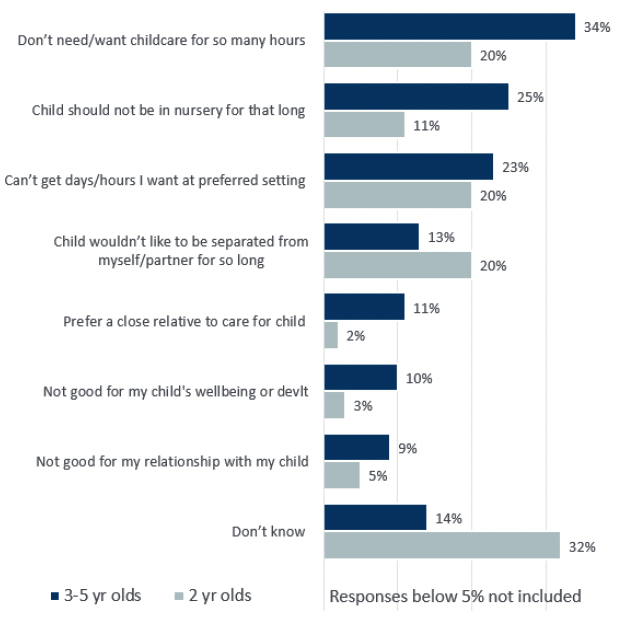
Nets[27]: 3-5 year olds
- don't need all the hours: 34%
- don't want child in nursery too long: 31%
- can't get the hours/days I want: 23%
- not good for child: 14%
- prefer relative looks after child: 13%
Nets: eligible 2 year olds
- don't need all the hours: 20%
- don't want child in nursery too long: 25%
- can't get the hours/days I want: 20%
- not good for child: 7%
- prefer relative looks after child: 3%
* Respondents could give multiple answers Parents of 3-5 year olds tended to give 1 response (68%), with around a tenth each giving 2 or 3 responses (15% and 9% respectively); parents of eligible 2s also tended to give 1 response (77%), with 15% giving 2 responses.
Reasons for not using funded ELC
As discussed above, only 3% of parents with a three to five year old surveyed said they had not used funded ELC. The main reason among this group was the child was due to start in ELC next term (August), with some of these children fairly recently having turned three. Lack of flexibility was a key barrier for a substantial proportion of the parents of three to five year olds not using funded ELC, in terms of opening hours, sessions and the settings available.
Generally, parents of two year olds did not take up their entitlement because they felt they did not want or need the place, typically because they felt their child was still too young, and because they are able to/preferred to look after their child themselves. A few mentioned being unaware of the availability of funded ELC or that they didn't know how to access it.
Figure 4: Main reasons for not using funded ELC entitlement
Q11, Q25 Why is that you do not use all the funded hours of early learning and childcare for your [3-5 year old/2-year old] that you are entitled to? Bases Q11: 177 (3-5s), Q25: 60 (eligible 2s)
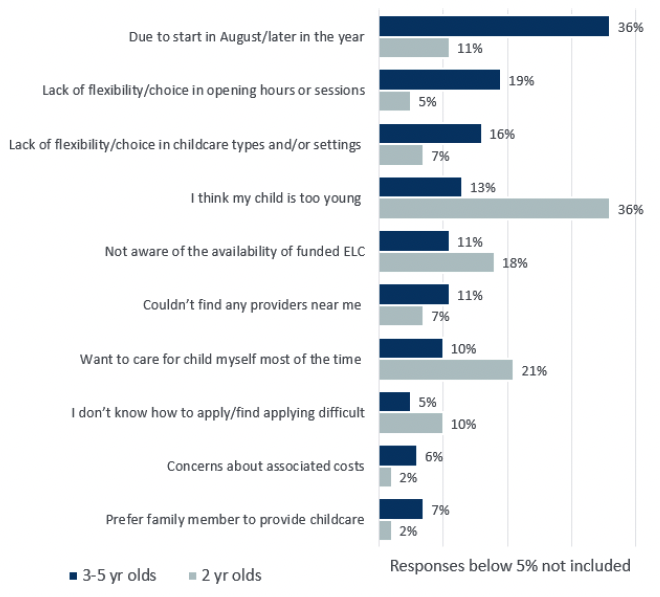
Nets: 3-5 year olds
- Child not eligible yet: 36%
- Don't need/want: 25%
- Not aware: 15%
- Access issues: 15%
- Lack of flexibility: 13%
Nets: eligible 2 year olds
- Child not eligible: 11%
- Don't need/want: 50%
- Not aware: 25%
- Access issues: 9%
- Lack of flexibility: 7%
* Respondents could give multiple answers. Parents of 3-5 year olds tended to give 1 response (66%), with a further 17% giving 2 responses, and 9% giving 3 responses; parents of eligible 2s also tended to give 1 response (79%), with a further 11% giving 2 responses.
Comparison with 2018
The proportion of parents with eligible children not using any of their entitlement in 2018, at 12%, was considerably higher than in 2022 (just 3% for three to five year olds). The reasons given for not using funded ELC in 2018 were similar to those given by parents in 2022 for not using their full entitlement: do not want to use ELC, prefer to look after their child themselves, as well barriers to use such as lack of awareness, flexibility and choice of setting/hours.
Summary of sub-group analysis: Use of ELC
Deprived areas/low income households
Were more likely than others to use funded ELC (eligible 2s only).
Less likely than others to say their reason for using funded ELC was to improve their work opportunities.
Single earner/lone parent households
Were more likely than others to use funded childcare (eligible 2s only).
Less likely than others to use all their funded ELC entitlement and less likely to say their reason for using funded ELC is to improve their work opportunities.
Rural areas
Less likely than others to use all their funded ELC.
Parents of children with ASN
Less likely than others to use funded ELC (eligible 2s only).
More likely than others to say their reason for using funded ELC was to benefit their child's learning/development/etc., and less than others likely to give reasons relating to work opportunities.
Other sub-group differences
No other sub-group differences were noted.
Flexibility of funded ELC
This section considers how well funded ELC meets parents' needs, in terms of the types of settings, the number of hours, and the timing of sessions.
Profile of use
The majority of parents used their funded ELC in a local authority nursery class (72% of three to five year olds, 61% of two year olds), with almost all of the others using private nurseries. Around a tenth (11%) of parents of two year olds used a family centre. Only a small minority used a childminder (3% of three to five year olds, 2% of two year olds). Typically, parents from low income and deprived areas, single earner and lone parent families, parents from rural areas and parents with children with ASN were more likely to use a local authority nursery and were less likely to use a private nursery.
Figure 5: Types of funded ELC used
Q3, Q16 What types of funded early learning and childcare has your child attended since August 2021? Bases: Q3 (3-5 yrs): 6698, Q16 (2yrs): 227
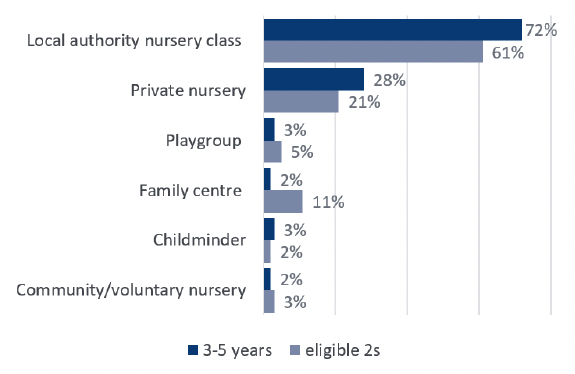
Overall parents were roughly split between using their funded hours all-year round and during term time only. Parents of children aged three to five were more likely to use their hours during term time only (57% vs 41%), whereas parents with younger children were more evenly divided (49% vs 47%). Parents of children aged three to five in deprived areas and single parent households were less likely to spread their entitlement across the whole year, while those parents with more than one child under the age of six and those in more rural areas were more likely to do so. Notably, when parents were asked in 2018 to consider how they would, hypothetically, prefer to spread a 1,140 hours entitlement across the school year, 70% overall said they would use their hours throughout the year, and just 25% they would use their hours in term-time only.
Figure 6: Use of funded ELC hours across the year
Q5, Q18 Which of the following best describes how the funded ELC you use is spread across the year? Bases: Q5 (3-5 yrs): 6698, Q18 (2ys): 227
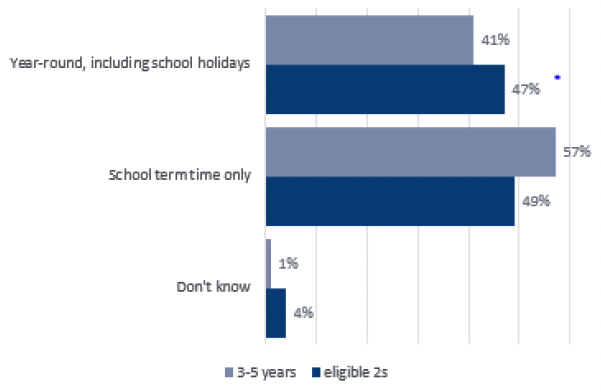
Figure 7 profiles how many hours parents use across the year. Overall, the older children (three to five year olds) tended to spend slightly longer in funded ELC than the younger children (two year olds), and in particular, to spend longer in funded ELC during term time There were few sub-group differences:
- three to five year olds – households with two working parents used more hours than those with no working parents both in term time (25.1 vs 23.9) and during the holidays (22.1 vs 17.0)
- two year olds – households with two working parents used more hours than those with no working parents in term time (23.6 vs 20.0) and during the holidays (21.5 vs 14.1)
Figure 7: Number of hours of funded ELC per week (banded) followed by table of means
Q6 and Q19 – In a typical week, roughly how many hours during [term-time / school holidays] does your child currently spend/ did your child spend at funded early learning and childcare? Base All using funded hours Q6: 3-5 yrs 6,080/2,312; Q19: 2 yrs 165/75
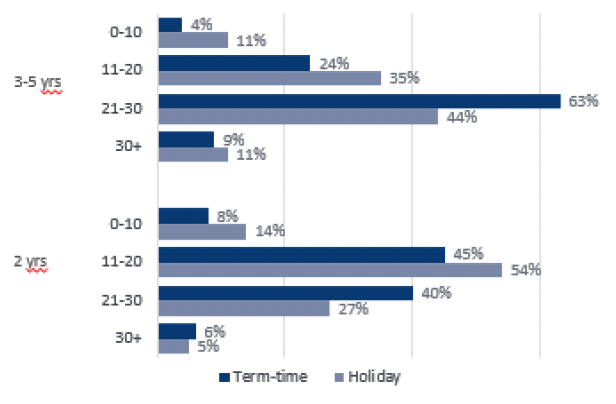
| 3-5 year olds |
Eligible 2 year olds |
|
|---|---|---|
| Term-time: hrs/week |
24.9 |
21.0 |
| School holidays: hrs/week |
21.4 |
17.6 |
Flexibility of funded ELC
Parents, on the whole, said they were satisfied with the flexibility they have been offered to use their funded hours in a way that meets their family's needs: 88% of those with a three to five year old and 92% of those with a two year old were satisfied, with 58% and 74% respectively very satisfied. Ten per cent of those with a three to five year old and 5% of those with a two year old were dissatisfied.
There were some sub-group differences among parents of three to five year olds (with no significant differences noted for the parents of the two year olds):
- households with no working parents are more likely than those with two working parents to be very satisfied (68% vs 56%)
- households on low incomes (less than £16,000) were more likely than those on incomes from £16,000-£60,000+ to be very satisfied (64% vs 54%-59%)
- parents in deprived areas were more likely than others to be very satisfied (62% vs 58%)
Figure 8: Satisfaction with flexibility of funded ELC hours
Q7, Q20 How satisfied or dissatisfied are/were you that you have been offered the flexibility to use your funded hours in a way that meets your family's needs? Bases: Q7: 6698, Q20: 227
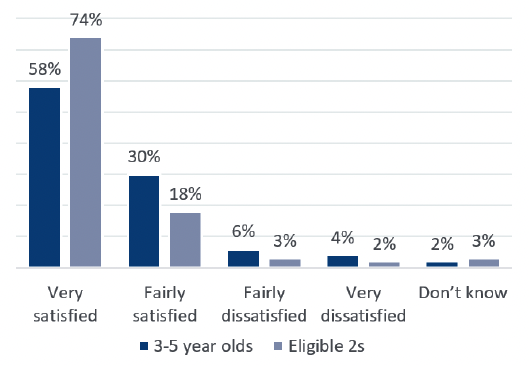
Parents who were dissatisfied with the way they could use their funded hours were asked what their preference would be. As the figure below shows, parents were fairly evenly split between the top three options of: being able to have longer sessions on fewer days each week, shorter session on more days each week, and sessions throughout the school holidays. This profile differs from 2018, which then found that most (65%) parents would prefer longer funded session on fewer days of the week. The marked reduction in the parents selecting this option is likely a consequence of the increase in funded hours, which has enabled many parents to secure longer sessions for their children.
Figure 9: Preferred use of funded ELC hours (3-5 years only)
Q7a How would you prefer to use your funded hours? Bases: Q7a:632
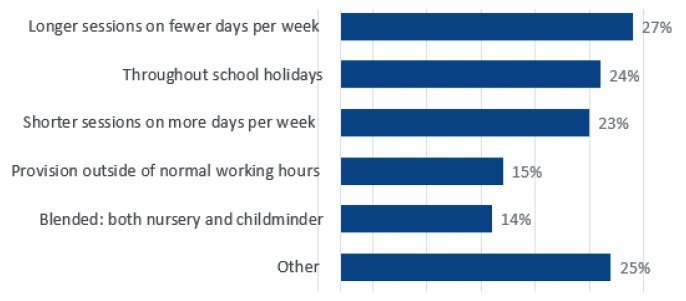
Note: only 12 parents of eligible two year olds said they would prefer to use their funded hour in a different way. The most common preferences were 'throughout the school holidays' and 'shorter session on more days'.
Respondents were invited to provide more information on the type of sessions they would prefer. The most common suggestions from those wanting longer sessions were the flexibility to start at 8am (39% of this group suggested starting around this time) and later finishes typically 4pm to 5pm (17%) and after 6pm (15%), while 17% simply asked for 'more flexibility'. Those who preferred more, shorter sessions per week suggested variations around the school day: 3pm finish (27% of this group made this suggestion) 9am to 10am start (24%) and match school hours (25%), as well as sessions over five days (26%).
Other respondents gave a range of suggestions, including term-time flexibility (23%), matching with school hours (21% of this group) ability to pay for extra hours (10%) and more general flexibility (23%), while some (5%) specifically mentioned they should only have to pay for what they use.
"I would like to choose hours that suit my working arrangements. Currently I am forced to use hours I don't need 90mins a week of my funded childcare is 'lost' as the placement starts at 8.00am, but my daughter does not attend the setting until 8.45am. This costs me £15 a week as I have to pay for the additional time she is there over and above my allocated hours." (One child not started school, single parent household, one parent in work, child(ren) with ASN)
"I do not need hours during school holidays and therefore miss out on hours that would be funded for my child if it was just term time. This leaves me more out of pocket." (Two children not started school, two parent household, two parents in work, no children with ASN)
"I wasn't aware that I would only be entitled to 22.5 hours a week as the whole 'advertisement' of it all is 30 hours funded. But because I work Mon-Fri throughout the whole year I am cut 7.5 hours a week. Which I don't think is very fair for the working mother as who only works term time but school teachers?!" (One child not started school, single parent household, one parent in work, no children with ASN)
Comparison with 2018
A number of the issues that faced parents in 2018 remained concerns in 2022: in particular local authority nurseries not being open long enough to cover the working day; and private nurseries charging by the half day, even if only part of the session is required. A key concern from 2018 that was rarely mentioned in 2022 was difficulty identifying/accessing private providers where they could use their funded entitlement.
The table below summarises sub-group analysis for 2022. There were some notable similarities with 2018, with parents in rural areas more likely to experience lack of flexibility in finding a provider/choice of hours, while those with at least one parent not in work were most likely to be happy with the flexibility of their provision.
Summary of sub-group analysis: Flexibility of funded ELC (three to fives unless otherwise stated)
Deprived areas/low income households
All more likely to use a LA nursery and less likely to use a private nursery.
Less likely than others to use their funded ELC hours across the whole year.
More likely to be satisfied with the flexibility offered by the funded hours.
Single earner/lone parent households
More likely to use an LA nursery, less likely to use a private nursery, and less likely to spread their funded ELC hours across the whole year than others.
More likely to be satisfied with the flexibility offered by the funded hours.
Rural areas
More likely to use an LA nursery, less likely to use a private nursery, and more likely than others to use their funded ELC hours across the whole year.
Parents of children with ASN
More likely to use an LA nursery, less likely to use a private nursery.
Other sub-group differences
Households with two working parents use more funded ELC hours than those with no working parents throughout the year for both age groups.
Parents with more than one child under 6 more likely to use a LA nursery, less likely to use a private nursery; and less likely to spread their funded ELC hours across the whole year than others.
Accessibility of funded ELC
Ease of transport
Nearly all parents found it easy to travel to their main provider of funded ELC, with 97% of parents of three to five year olds and 95% of parents of eligible two year olds saying they found it easy to travel to their funded ELC provider, and around three-quarters saying they found it very easy.
Those parents of three to five year olds with reduced capacity due to health conditions were more likely than those with no health conditions to find it difficult to travel to their main funded ELC provider (6% vs 2%).
Children with additional support needs
Parents with children eligible for funded ELC were asked if any of their eligible children had additional support needs. In total, 15% of parents said at least one of their eligible children has additional needs, most commonly language, speech and communication difficulties; social, emotional or behavioural difficulties; and autistic spectrum disorder (see table A2 in the appendix).
Parents were generally satisfied that funded ELC meets their child's additional support needs: 85% said they were satisfied, this includes 53% who said they were very satisfied.
Those with one pre-school child with an ASN were more likely to be satisfied than those with two or more children under the age of six (at least one with an ASN) (87% vs 81%). Those living in households with one or two parents in work were less likely to be very satisfied than those living in households where no parents work (49% or 51% vs 63%).
Those with an income of more than £30,000 were less likely to be very satisfied compared to those below £30,000:
Proportion of each income band saying 'very satisfied' that ASN meets their child(ren)s needs:
Less than £16,000: 57%
£16,000 to £29,999: 60%
£30,000 to £44,999: 45%
£45,000 to £59,999: 44%
£60,000+ 47%
Nearly one in ten (9%) parents of a child/children with ASN said they were dissatisfied with how funded ELC meets their child's additional support needs. Those with two or more pre-school children were more likely to be dissatisfied than those with one child (12% vs 7%).
Those dissatisfied were asked an open question to explain why they were dissatisfied with their access to funded ELC provision for their child(ren) with additional support needs. An analysis of these responses indicates that the main reasons for dissatisfaction were:
- staff not fully / appropriately trained (33%)
- not enough support given (28%)
- poor communications with provider (18%)
- hours unsuitable (11%)
- slow diagnosis / provision of service delayed (9%)
- no key-worker available / lack of 1-1 support (9%)
[Base 82 responses]
The following quotes are examples of issues raised in responses to the open question.
"They don't have enough staff although it follows guidelines per adult child ratio but that does not take into account my child's needs, meltdowns, learning delays, sensory issues and that he needs more adult support than your average child. I was told on my son's 2nd year deferred year I cannot move him although I was unsatisfied with his overall care at the nursery as the [local authority] don't have alternative placements. My son lashes out at peers at nursery there is not enough staff to supervise at all times and my son does not receive the extra staff to help him learn at his pace as they have other children to deal with." (One child not started school, two parent household, one parent in work, child with ASN)
"We did try our oldest child with a split placement with her private nursery and the council nursery attached to the school she will be going to. The hours are not suitable for us at all but as I am self-employed I was willing to sacrifice some time if it was a good thing for my daughter. All we wanted was 2 days at the council nursery and 3 days at the private nursery, which she has attended since she was 6 months old. The private nursery were fine with this as we were already in level 0. The council nursery were informed of our request and agreed to it. They were also informed both in person and in writing about my daughters severe eating issues which we have been struggling with since she started to wean. They said they would make provision for her and support this. However, the day she started I went with her. No one knew about the split placement and no one knew about my daughters eating issues which I was very concerned about. The following day I was told that the split placement was likely not to be possible and I'd more or less have to choose which nursery my daughter would go to. We obviously chose the private nursery as she is happy there and they are great helping her with her eating issues. I had zero faith the council nursery would help. This has cost us tremendous financial difficulty and we struggle every single month to pay our almost £900 a month bill…"[28] (Two children not started school, two parent household, two parents in work, child(ren) with ASN)
Difficulties experienced by parents of children with ASN
When asked if they had experienced any of the issues listed on the figure below, the majority of parents of children with ASN said there were no difficulties (69%). Those who did have issues most commonly cited staff not having enough time available to meet the needs of children and a lack of information on how providers support children with ASN. Some were lacking confidence in the staff's qualifications, knowledge and experience.
Figure 10: Difficulties experienced finding funded ELC that meets additional special needs
Q38 Have you experienced any of the following difficulties finding funded early learning and childcare that meets the additional support needs of your child(ren)? Base All parents with a child with ASN, 1008
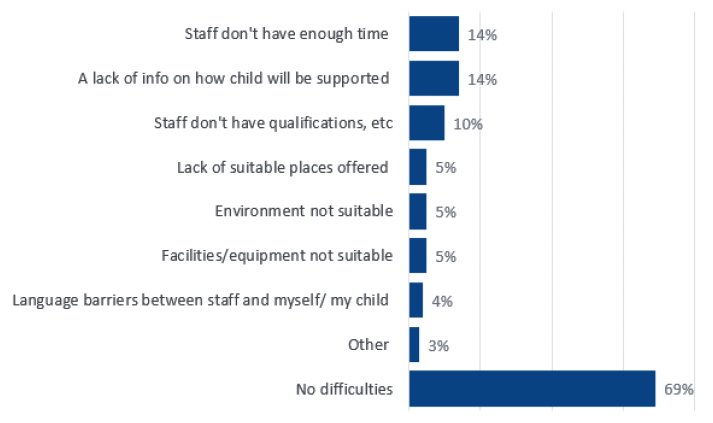
As with other issues of satisfaction, those with income of more than £30,000 were more likely to report difficulties compared to those below £30,000:
Proportion of each income band reporting no difficulties finding funded ELC for their child with ASN
Less than £16,000: 79%
£16,000 to £29,999: 74%
£30,000 to £44,999: 62%
£45,000 to £59,999: 67%
£60,000+: 60%
Similarly, parents in the most deprived SIMD areas were less likely to report difficulties compared to parents from the least deprived SIMD areas (38% vs 26%).
Numbers were too small in most cases to do detailed analysis by the child's type of additional need. However, we can see that parents of children with social, emotional or behavioural difficulties and Autistic spectrum disorder were most likely to report having experienced difficulties, while parents of children with sensory disabilities (such hearing or visual impairments) were least likely:
Proportion that have experienced some difficulties finding ELC that meets their needs:
Social, emotional, behavioural: 43%
Autistic spectrum disorder: 42%
English as a second language: 38%
Health: physical/mental health: 34%
Language, speech, communication: 32%
Sensory impairment: 21%
All: 31%
Parents of children with autistic spectrum disorder and those with social, emotional or behavioural difficulties were especially likely to mention difficulties with lack of information on how providers will support children with additional needs (23%/ 22% compared with others 9%-16%) and lack of confidence in the staff being able to meet child's needs (21%/23% compared with others 9%-16%)
Comparisons with 2018
These findings are broadly consistent with the 2018 survey, which found that most (57%) parents were satisfied with their access to ELC that meets their child's needs. However, around half (48%) of parents with a child with ASN had experienced difficulties accessing suitable provision in 2018, compared with 31% in 2022. The types of difficulties experienced were similar to those encountered in 2022: lack of information on how provider will support their child, concerns that staff will not have enough time to support their child, and worries that staff do not have the right qualification, skills and experience to look after their child.
Choosing a service provider for a child with ASN
When parents were asked about the basis on which they chose a funded ELC provider for a child with ASN the most commonly mentioned qualities were connected to staff who get to know how to support the child, who meet the needs of the child, who collaborate and have time to meet the child's needs. It is interesting to note that 'staff not having enough time to know how to support my child' is the most often mentioned difficulty experienced (Q38 above) and the most often mentioned reason for choosing a provider.
Figure 11: Choosing a provider that meets additional support needs
Q39 Which of the following do you base your decision on when choosing a funded early learning and childcare provider to meet the additional support needs of your child(ren)? Base All parents with a child with ASN 1,008
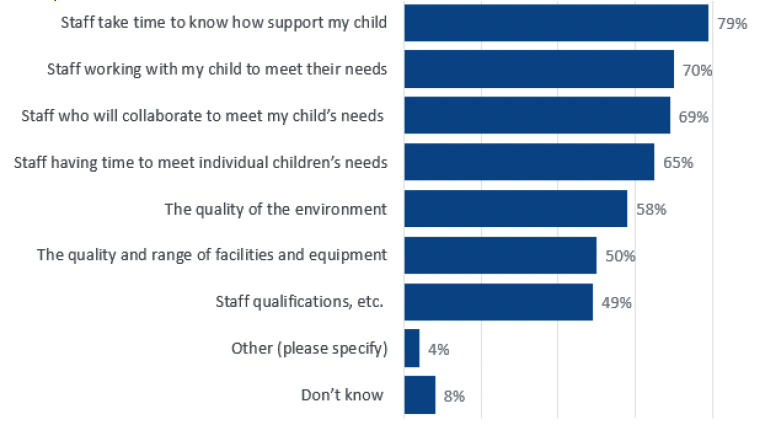
Choosing a funded ELC provider and quality of funded ELC
This section considers parents' views on their funded ELC provider and the impact that funded ELC has had on their lives.
Choosing a funded ELC provider
Choosing their ELC provider is a, important decision for many parents. As Figure 12 shows, parents are most likely to consider the provider's location and reputation when selecting the setting. Other factors such as continuity (being attached to the same school their child will go to/attended prior to funding), the opportunities open to the child (for example, outdoor activities, Gaelic), siblings currently/previously attended; and reliability were also considerations.
Figure 12: Choosing a funded ELC provider
Q30 Thinking about the provider you use for your child(ren)'s funded early learning and childcare hours, how did you choose your current provider? Base: All eligible for funded ELC 6762
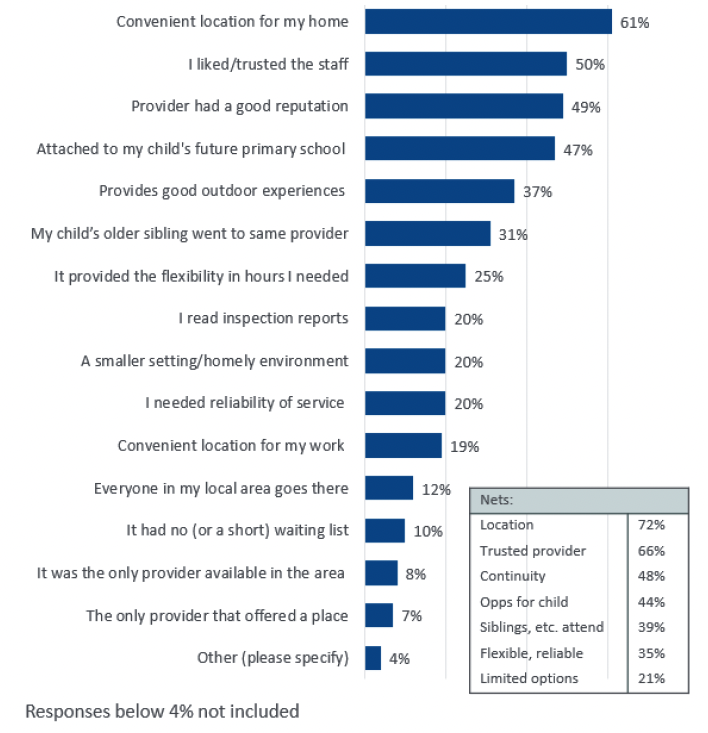
Flexibility and reliability were significantly more important to households where both parents were in work than those with no/one parent in work (39% vs 25% and 31%) and for parents on high incomes (over £60,000) compared with those on lower incomes (45% vs 28%-38%).
Just over a fifth of parents gave reasons linked to restricted options (such as short/no waiting list, the only option in the local area). Parents in rural areas were more likely than others to give one of these reasons (27% vs 19%), as were parents who had a child with ASN (25% vs 20%).
Quality of funded ELC provision
Overall, parents were satisfied with the quality of the provision from their main funded ELC provider. Figure 13 below shows clearly that 97% of parents were satisfied with the quality of their provider, with 70% very satisfied. While levels of dissatisfaction are extremely low, there are a few sub-groups of parents that are more likely than others to be very satisfied: those with eligible two year olds compared with three to five year olds (78% vs 70%), no earners in the household compared with households with one/two earners (76% vs 71%/69%) and parents whose children do not have ASN compared with others (70% vs 66%).
Figure 13: Satisfaction with the quality of funded ELC provider
Q31 Thinking about the main provider that you use for your funded early learning and childcare hours, how satisfied or dissatisfied are you overall with the quality of the provision? Bases: Total 6762, Those with eligible 2s 247, Those with 3-5s 6608
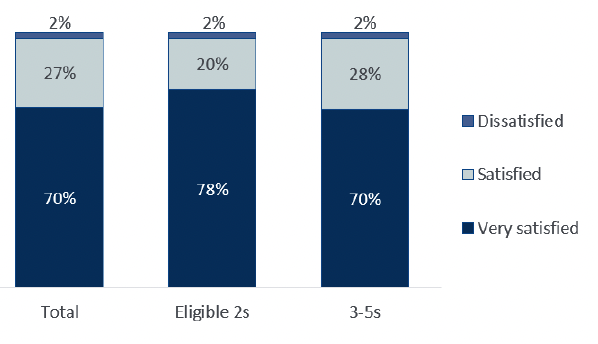
Impacts and benefits of funded ELC
The survey asked about the impact that funded ELC has had on parents' lives, the activities they have been able to undertake because of access to funded hours, and the contribution to their health and wellbeing.
The most common impacts of the funded hours have been to enable parents to work or look for work (74%) and to have time to think about what they may do in the in the future (mentioned by 71%). The next most commonly mentioned were wellbeing impacts, although substantially less frequently: just under half have been feeling happier (47%), less stressed (46%) and have had time to look after themselves more (44%).
- Being able to work/look for work was more likely to be mentioned by two parent families (76% vs 65%), those with two earners (84% vs 40% or 62% for those with no or one earner) and those in groups earning more than £16,000+ compared with those earning less than £16,000 (71%-79% vs 64%). These sub-groups were also more likely to say their funded hours enabled them to increase the number of hours they work.
- Having time to think about the future was more likely to have been said by those from deprived areas compared with non-deprived areas (77% vs 70%), lone parents compared with couples (76% vs 70%), people in no or single earner households compared with two-earners households (78% or 75% vs 68%), as well as by younger (under 25s) parents compared to older parents (90% vs 64%-80%). These groups were generally also more likely than others to say that they were using their hours to study/develop skills, to care for others, and to look after themselves better and have been feeling happier and less stressed.
Figure 14: Impact of funded ELC
Q43 And, could you please tell us how much you agree or disagree with the following statements about the impact of funded early learning and childcare on you? Bases: 6,853
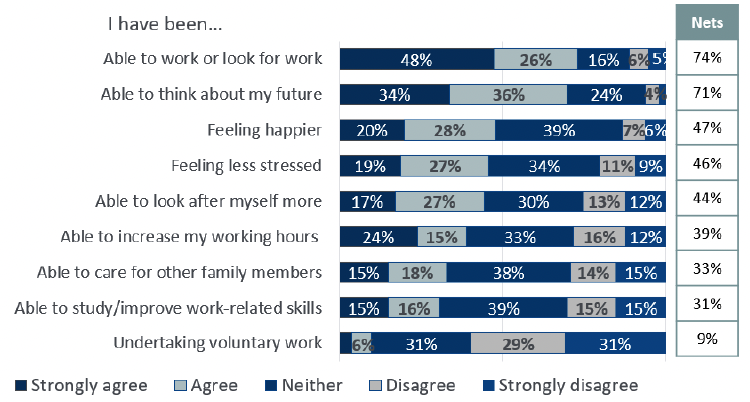
Summary of sub-group analysis: Quality and accessibility of funded ELC
Deprived areas/low income households
Were less likely than others to mention issues relating to continuity for child, location, and flexibility and reliability when choosing their funded ELC provider.
Were more likely to have used funded ELC to think about their future, to study, to care for others, and to have had more time to look after themselves. And less likely to have (looked for) work/increased hours worked.
Single earner/lone parent households
No-earner households more likely to be satisfied with the quality of their provider.
More likely to have been using funded ELC to think about their future, to study, to care for others and have had more time to look after themselves, feel happier and less stressed.
They were less likely to have used funded ELC to work/look for work, to (look for) work/ increased hours worked. Households with no/one earner more likely than others to have taken up voluntary work.
Rural areas
More likely than others to have had restricted choices when choosing their funded ELC provider.
More likely than others to have used their funded ELC hours to increase the hours they are working.
Parents of children with ASN
More likely than others to have had restricted choices when choosing their funded ELC provider, and less likely than others to be satisfied with the quality of their provider.
More likely than others to be using funded ELC to have more time to look after themselves, and to have been feeling happier and less stressed.
Other sub-group differences
Parents with English as a second/additional language were less likely than others to mention continuity for child when choosing their funded ELC provider.
More likely than others to be using funded ELC to think about their future, to study, to care for others, to have undertaken voluntary work, and to have increased hours worked. More likely than others to be using funded ELC to have more time to look after themselves, and to have been feeling happier and less stressed.
Parents with eligible two year olds more likely to be satisfied with the quality of their provider.
Younger parents (under 25) more likely to have used funded ELC to think about their future, to study, to care for others, and have more time to look after themselves. Less likely to have (looked for) work/increased hours worked.
Parents with one child were more likely than others to have used their funded ELC to work/look for work (76% vs 69%) increased hours worked.
Parents with a health condition that reduced their capacity a lot: less likely than those with no health condition to have used their funded ELC hours to work/look for work.
Respondents were asked if they had any further comments about the impact of the expansion of funded ELC to 1,140 hours per year. Two-fifths responded to this question. Most of the comments were positive overall. Many (28%) were straightforward praise, such as "it's a fantastic thing", "I think it's great", "thank you", "this is an incredible initiative, thank you". However, the largest group of comments related to the positive financial impacts of the funded hours, with parents commenting on the huge difference funded ELC has made to them being able to work, study and simply access childcare. Many qualified these comments, noting that more flexibility, longer hours, extending eligibility to younger children would enhance the scheme's value to them.
"I couldn't work if these hours weren't available as cost of childcare wouldn't cover my income." (Two children not started school, two parent household, two parents in work, no children with ASN)
"I think this is fantastic as childcare can be so expensive and it takes a bit of financial pressure of my partner and I. We will need to pay for some extra hours because we both work full time but this is a great help." (One child not started school, two parent household, two parents in work, no child with ASN)
"It is greatly appreciated and takes a lot of pressure off to find money to cover childcare, the costs of which are huge. Very pleased to hear that this help might be further extended to cover younger children." (Two children not started school, two parent household, two parents in work, no children with ASN)
Respondents stressed the social benefits of the funded ELC, both in terms of helping their child's learning, development and confidence, and supporting the parent's wellbeing and mental health.
"It is fantastic, I am so incredibly grateful for it as it not only allows me to work which helps the family income (and is vital just now) but also is beneficial for my mental health. It is also very beneficial for my child as preparation for school/ socialisation/fun. I could not afford to send her to nursery for more than a day if I had to pay for it and am aware that I just cannot give her the experiences and learning at home that she gets at nursery." (One child not started school, single parent household, one parent in work, no child with ASN)
Negative issues within the comments were around not being able to get the hours needed, and the cost /affordability of childcare. The main frustrations raised were around the access and administration of funding by local authorities, flexibility of providers and how they administer the scheme; whether parents could access the hours they wanted, when they wanted; and parents having to pay fees for additional/out-of-hours care. Parents mentioned cases of children turning three in March 2022 but not being eligible for a place until the August term; of having to pay for many more hours than they use as sessions fees are based on a standard day, and the constraints of using local authority provision.
"The discrepancy between when the funding kicks in per local authority is infuriating. Some children benefit from the day they turn 3, others the school term after 3. That is a sheer postcode lottery and date lottery too. For example, we lose out on £1600 of funding by 2 days in [local authority]. An absolute joke." (Two children not started school, two parent household, two parents in work, no children with ASN)
"Infuriating that you cannot top up the funded hours at the local authority nursery i.e., pay for additional hours required." (One child not started school, two parent household, two parents in work, no children with ASN)
Figure 15: Comments on impact of ELC
Q57 Is there anything else you would like to say about Scottish Government's expansion of funded ELC to 1,140 hours per year? base: 3510
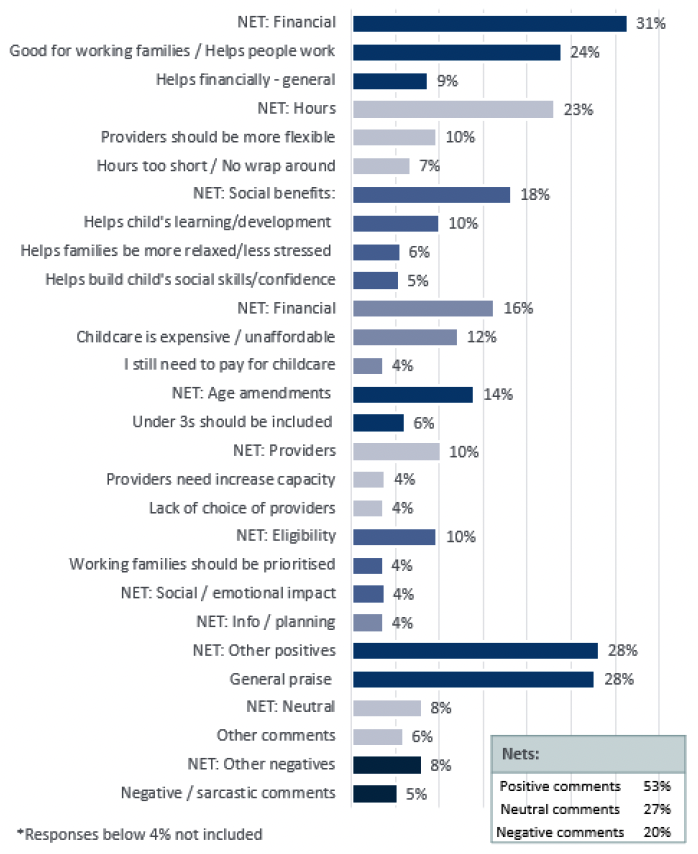
Effect of Covid-19 on use of funded ELC
The Covid-19 pandemic delayed the statutory duty for the increase in hours of funded ELC by a year to August 2021. This section of the report considers the impact of Covid-19, and in particular, the impact of Covid-19 restrictions on the use made of and experiences of funded ELC since August 2021. It will help establish the extent to which, if any, the pandemic continued to affect parents' access to and experience of funded ELC.
Direction of change
The pandemic had not impacted the use of ELC for the majority (74%). The biggest impact for those who were affected was a reduction of funded ELC (18%). A minority (4%) experienced an increase in use of ELC or other impacts (3%).
Lack of impact increased in line with income. Those with income of more than £45,000 were more likely to have felt no impact compared to those below £30,000:
Proportion of each income band reporting that Covid-19 had not impacted on ELC use since August 2021
Less than £16,000: 70%
£16,000 to 29,999: 71%
£30,000 to 44,999: 73%
£45,000 to £59,000: 76%
£60,000+: 77%
Parents of children with ASN were more likely than other parents to have experienced some impact (increased use, reduced use or other) (32% vs 25%).
Notably, those who find it difficult to get to their provider were more likely than others to reduce their use of funded ELC (29% vs 18%).
Those whose use of funded ELC was reduced were more likely to be in the most deprived SIMD quintile than the least deprived SIMD (20% vs 17%).
Reasons for reduction in hours
The main reasons given for reducing hours due to the pandemic were linked to providers being closed. There were also issues with admissibility (for example, having to self-isolate) and accessibility. Some providers placed restrictions on the hours they could provide.
Figure 16: Impact of Covid-19, reduction in funded ELC[29]
Q34a You said you have reduced your use of funded early learning and childcare since August 2021 as a result of Covid-19. Please explain why this was. Base: All reducing funded hours: 1,215
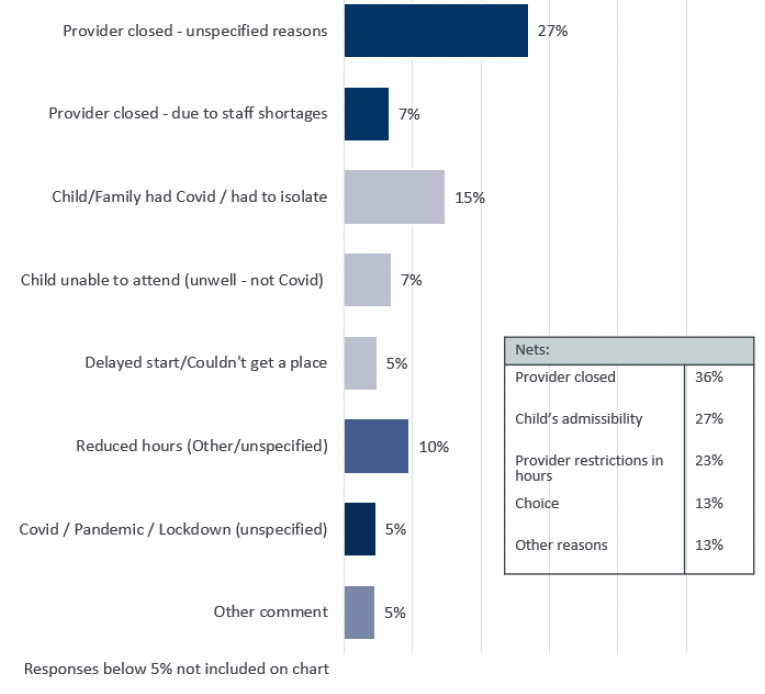
The following quotes illustrate some of the reasons for reduction in hours.
"Staffing issues, staff off with illness throughout November/December 2021 and January 2022 and no cover to be able to open the nursery. Even now there are still staffing issues and the nursery being closed at short notice occasionally. The issue of support staff in [x council] area needs to be addressed." (One child not started school, two parent household, two parents in work, no children with ASN)
"Because of Covid-19, nursery and school can't go in and out at the same time (this is still the case although restrictions no longer in place). I can't hang around for an hour at the school gate after P2 child has been let out because nursery won't be out for another hour, therefore I pick up nursery child at lunch time when he would definitely benefit from staying longer. I already stand in the cold and rain most mornings (this is rural Scotland) with my nursery child after dropping my P2 child to school for 20-30 minutes waiting for nursery to open. If nursery were willing to line up their pick-up and drop-off times with school it would be so much more family friendly." (One child not started school, two parent household, one parent in work, child(ren) with ASN)
"My child attends 2 nurseries and so catches every bug from both schools resulting in not being able to attend due to having a runny nose, slight temperature and other 'Covid-19 symptoms' and a lot of absences occurred meaning I also had to present as absent from my college course and yet I am currently having to drop hours at his 2nd nursery and possibly my child's main nursery now before my course ends even though I know full well my child has not used all of his entitled hours due to these absences. My degree course is hinging on my performance in these vital few weeks and I may well not be able to attend due to these lack of funded hours available." (One child not started school, single parent household, no parents in work, no children with ASN)
Reasons for increase in hours
The main reasons for increasing hours were linked to work commitments, hours changing and being a key worker. Parents also cited the need to support their child's development. Some mentioned the increase in availability of funded ELC. The following quotes illustrate some of the reasons for an increase in hours.
"Covid-19 restrictions had a huge impact on my son's ability to socialise with children his own age. Although he had issue with a speech delay before lockdowns, all additional support and therapy was stopped. I felt that it was extremely important to give him the opportunity to use the extended hours to help improve his social skills. Was also very grateful that the extended hours allowed us to do so as we would not have been able to afford private childcare." (One child not started school, two parent household, one parent in work, child(ren) with ASN)
"As a family staying in a small home, with no informal childcare options, we grew overwhelmed by the constancy of having the kids around with no facilities open, no places to visit, no friends to see, and we needed to get them out the house for our own sanity and to make time for work. If there had been no lockdowns we would have kept going to local playgroups and joined clubs and the rhythm of life would have been much easier. We have very few parent friends now, partly because we weren't attending clubs and playgroups at a crucial age, so we still find it difficult to arrange playdates with our kids' friends." (Two children not started school, two parent household, two parents in work, no children with ASN)
Figure 17: Impact of Covid-19, increase in funded ELC
Q33 You said you have increased your use of funded early learning and childcare since August 2021 as a result of Covid-19. Please explain why this was. Base All increasing funded hours: 288
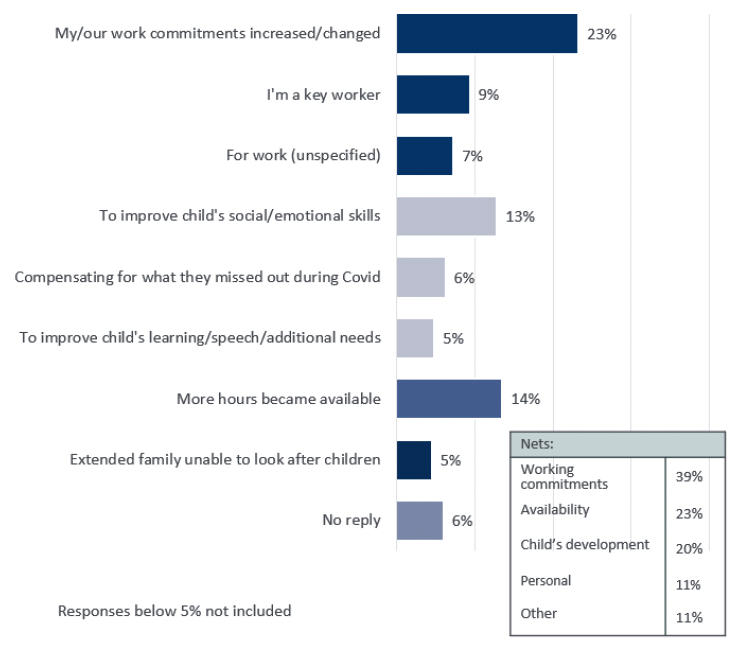
Other impacts of Covid-19
Other impacts of the pandemic included providers being less flexible, changing availability and decrease in accessibility. Some also mentioned concerns they had with their child's development.
"Pre-Covid-19, we were in a nursery within our own local authority. When lockdown kicked in, these obviously shut and when they reopened, they had reduced places and we were no longer able to use a local authority provider and had to seek private providers, initially a childminder and then a private nursery in a different local authority, as none of those within my own local authority could offer the flexibility we needed to use our 1,140 hours the way we wanted i.e. you could only have one session per day and we needed to use the allowance over fewer days but for more than one session each day." (One child not started school, two parent household, two parents in work, child(ren) with ASN)
"It was stopped for a period (as was everywhere), it made the interaction with the nursery almost non existent which affected the ability to track my child's progress, it was inconsistent and staff changes meant even more inconsistency but you can't help illness from Covid-19. It also reduced the opportunity to meet other Parents as the drop off pick up was so rushed." (One child not started school, two parent household, two parents in work, no children with ASN)
Figure 18: Other impacts due to Covid-19
Q34b You said your use of funded early learning and childcare since August 2021 had been impacted as a result of Covid-19. Please explain why this was. base: all experiencing other impacts as a consequence of Covid: 223
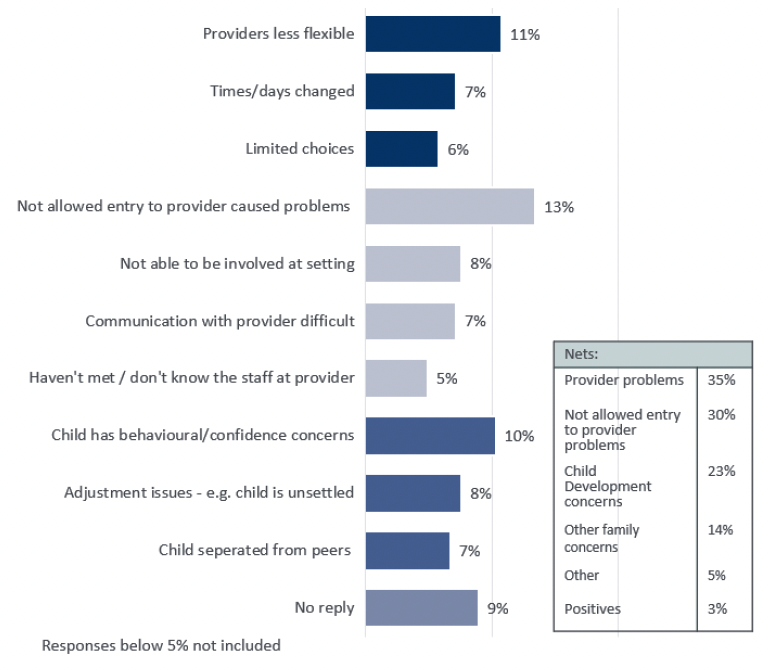
Affordability of childcare
This section relates to all those with a pre-school child (0-5 years) and paying for childcare. This will include parents who are not yet entitled to funded ELC as well as those who are topping up their funded hours.
Amount spent by age
The section on use of childcare showed that 36% of parents paid for some of their childcare. Figure 19 shows that the average household spend per month on childcare declines with the age of the child: falling from £533 for children aged under three years, to £306 for those aged three to five years. It seems highly likely this reflects the impact of funded ELC on reducing costs for families once their children are old enough to benefit from the entitlement. Forty-four per cent of parents of children under three are paying more than £500 per month of their childcare, this compares to just 13% for those aged three to five years.
- under three years: the amount spent on childcare increases as income rises, from £390 per month for those on incomes of up to £16,000, to £623 for incomes of £60,000+; and spending is higher among households where English is a second language (£640 vs £512)
- three to five years: households earning more than £60,000 spend more on childcare than households on lower incomes (£330 vs £251-284); parents with a child with ASN spend more than those whose child does not have ASN (£342 vs £302); and spending is higher among households where English is a second language (£372 vs £275)
Figure 19: Amount spent on childcare for pre-school children, total spend on children in each age-band[30]
Q40 On average, how much do you currently spend in total per month on childcare for your children who have not yet started primary school? Please include all costs, any fees that you pay, as well as any additional expenses that you are responsible for. Bases: 0-2s 1703, 3-5s 1477
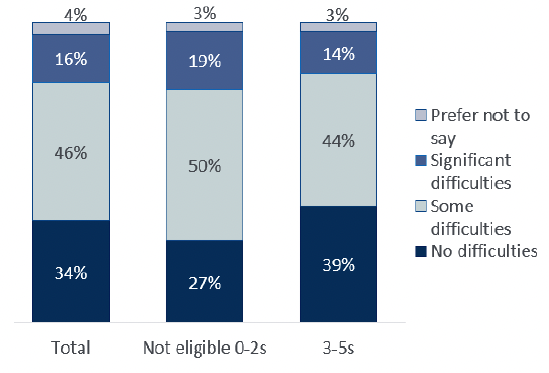
Table 7 below compares average costs of childcare according to the mix of care used: quite clearly the cost of childcare is higher on a like for like basis across the age-groups, which is likely related to the higher fees charged for younger children to accommodate higher staffing ratios. For both age-groups paid-only is the most expensive option.
Q40 Bases: 0-2s 1703, 3-5s 1477
| 3-5 yrs |
0-2 yrs |
|
|---|---|---|
| Overall average |
£293.6 |
£508.2 |
| Funded + paid + informal |
£208.9 |
£425.4 |
| Funded + paid |
£308.1 |
£572.6 |
| Paid + informal |
£397.0 |
£395.6 |
| Paid-only |
£523.5 |
£625.6 |
Difficulties affording childcare
Parents were also asked if they had experienced difficulties in affording childcare for their pre-school children. Overall, around a third (34%) had not experienced any difficulties, while three fifths (62%) had experienced some difficulties including 16% who had experienced significant difficulties.
Figure 20: Difficulties affording childcare by eligibility for funded ELC
Q41 Have you experienced any difficulties in the last 12 months affording your childcare costs for children below primary age? Bases: Total 2882, 0-2 1793, 3-5s 1961
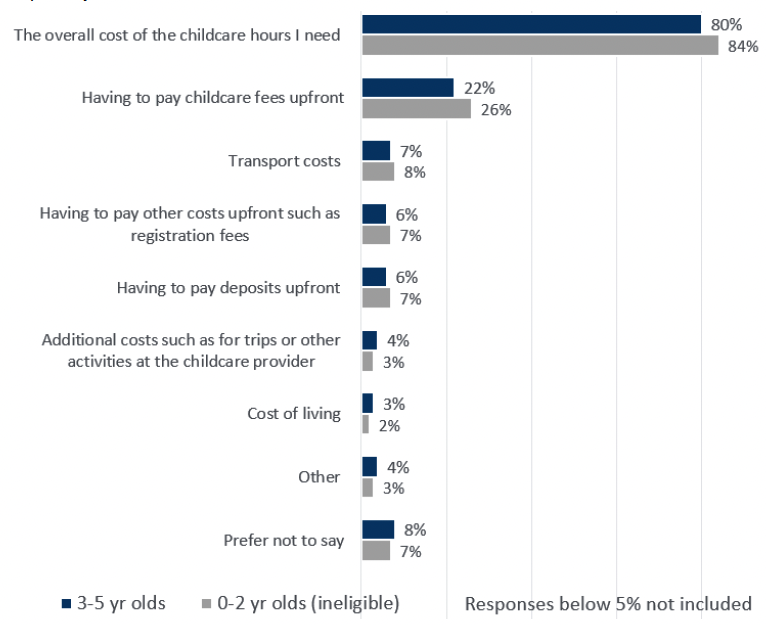
Perhaps not surprisingly, given their access to funded ELC, parents of three to five year olds were significantly less likely to have had difficulties than parents of children aged two years old and younger. The other key sub-groups that reported significant difficulties affording their childcare costs were the following:
- lone parents compared to couples (30% vs 15%)
- no/single earner compared to two earner households (52%/26% vs 14%)
- parents in deprived areas compared to others (29% vs 14%)
- parents of a child with ASN (25% vs 13%)
- parents with English as an additional or second language (21% vs 15%)
Sources of difficulties
The main difficulties experienced by parents of children in each of the age groups were very similar: simply affording the cost of childcare was the main issue (a difficulty for around four-fifths of those who pay for childcare) and paying for fees in advance (an issue for around a quarter).
Figure 21: Difficulties affording childcare by eligibility for funded ELC
Q42 Have any of the following made it difficult to afford childcare? Bases: ineligible 0-2s = 1240, 3-5s = 1133, Respondents could give multiple answers. Most respondents gave either 1 or 2 responses: 63% of parents of 0-2s gave 1 response, and 16% gave 2, for parents of 3-5 years olds it was 73% and 18% respectively
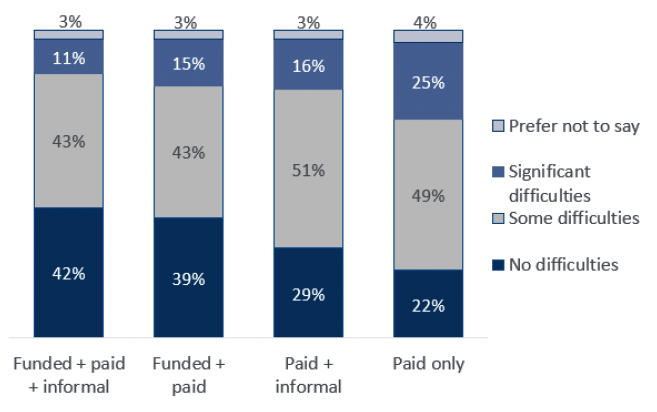
Notably, two parent households, households with two parents in work, and higher income households were more likely to identify the overall cost of childcare as being the main issue, with upfront fees also mentioned by some as a concern. This fits with these households tending to use higher amounts of childcare and spending more on childcare. Single parents, no/single earner households, low income households, and households where English is a second/additional language also raised the overall costs of childcare as the main issue, but were more likely than others to raise concerns about paying fees, deposits and other costs upfront.
Figure 22 below shows a clear relationship between the profile of childcare used and difficulties experienced in affording childcare. Perhaps not surprisingly, parents using only paid-for childcare, and therefore spending most on childcare, were most likely to experience difficulties affording childcare. This group were also most likely to experience significant difficulties, with just 22% saying they experienced no difficulties. As the figure demonstrates, the situation improves for those who use a mix of paid and informal childcare. There is a significant improvement for those using funded ELC, with around two-fifths saying they do not experience difficulties affording their childcare.
Figure 22: Difficulties affording childcare by profile of childcare used
Q41 Have you experienced any difficulties in the last 12 months affording your childcare costs for children below primary age? Bases: Funded+paid+informal 862, Funded+paid 904, Paid+informal 505, Paid only 611
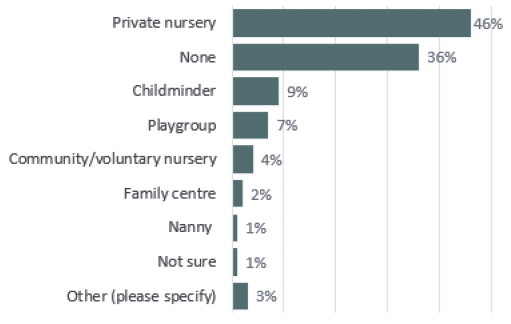
Summary of sub-group analysis: affordability
Deprived areas/low income households
0-2s: Low income households tend to spend less on childcare than others.
Were most likely to report significant difficulties affording childcare costs, and were more likely than others to raise concerns about paying fees, deposits and other costs upfront.
Single earner/lone parent households
0-2s: Single earner households spend less on childcare .
Were most likely to report significant difficulties affording childcare costs and were more likely than others to raise concerns about paying fees, deposits and other costs upfront.
Rural areas
No significant differences.
Parents of children with ASN
Were most likely to report significant difficulties affording childcare costs.
Other sub-group differences
Parents with English as a second/additional language: spending on childcare is higher for all age groups among households where English is a second language, and these parents were most likely than others to report significant difficulties affording their childcare costs.
They were also significantly more likely to raise concerns about paying fees, deposits and other costs upfront.
Older parents generally spent more on childcare than their younger counterparts.
Younger parents were more likely to report significant difficulties affording their childcare costs.
Provision for younger children (one and two olds[31])
Scottish Government has committed to build the evidence base required to inform the development of a high quality offer of early learning and childcare for one and two year olds, as well as developing wraparound care for school-age children. This section of the report considers the views of parents with a child/children aged under three not receiving funded ELC. It explored if they would be interested in using funded ELC for their young child, and the aspects of ELC settings that would be most important to them. It starts by establishing their current childcare provisions.
Profile of use of childcare
Parents where asked what type of paid-for childcare they use for their child/children under the age of three. The most frequently mentioned was private nursery (46%), with relatively few using other types such as a childminder (9%) or playgroup (7%). A small number mentioned other options, typically family and friends or school nurseries. Over one in three (36%) parents did not pay for any type of childcare or early learning themselves.
The following groups were all more likely to pay for private nursery:
- households with one child who has not yet started school (64%, compared with 36% with two or more children that had not started school)
- households with two working parents (54%, compared with 27% of households with one parent in work and 8% with no parents in work)
- households with a household income of £60,000 or more (64%, compared with 23% of households with an income of less than £16,000).
Figure 23: Use of paid-for childcare
Q26 - What types of childcare or early learning that you pay for yourself has your child attended since August? base: (Ineligible for ELC aged 0-2 yrs in paid-for childcare) 3,116
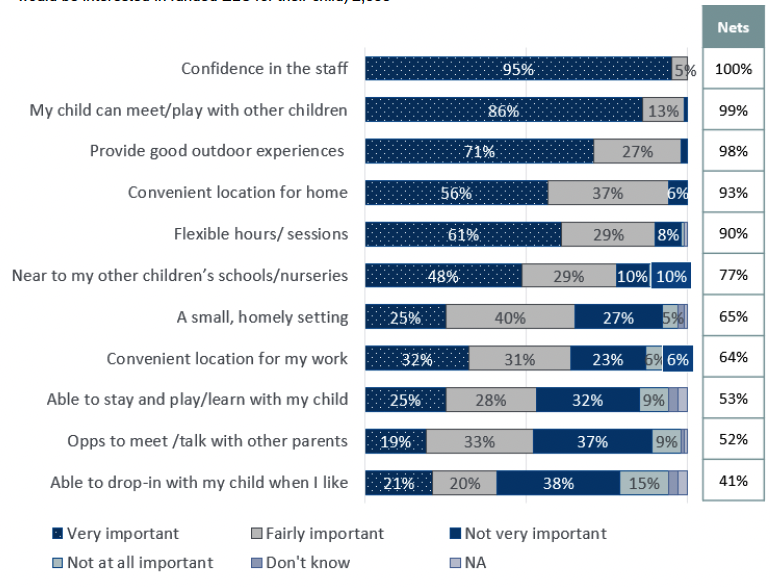
Reasons for not using paid-for childcare
Parents who did not use paid-for childcare for their child/children under the age of three were asked if there were reasons for this. Two principal reasons were given: parents could not afford to pay for childcare (53%), and they wanted to look after the child themselves (47%).
Although two-parent households were more likely to pay for childcare themselves (see above), they were also more likely than single parent households to want to look after their child themselves (49% vs. 36%); and less likely to report they can't afford to pay childcare (52% vs. 62% of single parent households). Together, these findings suggest that two-parent households have greater autonomy over the decision of whether to use paid-for childcare services or not, whereas single parent households are less likely to have the choice.
Q27 Are there particular reasons that you are not using childcare that you would pay for yourself for your child aged 0-2 years? Base (Parents of children ineligible for funded ELC aged 0-2 years not currently paying for childcare) 1111
| 0-2 year olds (ineligible for FELC) |
|
|---|---|
| I can't afford to pay for childcare |
53% |
| I want to look after my child myself |
47% |
| I think my child is too young |
30% |
| Prefer a grandparent/ other close relative looks after my child |
24% |
| Child wouldn't like to be separated from myself or my partner for so many hours |
11% |
* Respondents could give multiple answers: around half (53%) gave 1 response, while 25% gave 2 responses, and 11% gave 3 responses.
Interest in expansion of funded ELC to one and two year olds
Parents of children aged under three and currently ineligible for funded ELC were told that the Scottish Government is committed to extending funded childcare to one and two year olds and asked how interested they would be in using funded childcare or early learning for their child under three years. Almost all (91%) of these parents said they would be interested, with most (80%) saying they would be very interested. Just 7% said they would not be interested.
The groups of parents most likely to be interested in the funding extension included:
- households with two working parents (93%, compared with 87% with one working parent and 86% with no working parents)
- those in urban areas (93%, compared with 89% in rural areas)
- parents who just have a child/children aged under three years compared with parents who have a child/children aged three to five years as well (97% vs 88%)
Factors considered when choosing childcare
Parents interested in a Scottish Government funding extension for ELC for children under three years were asked how important a range of factors would be when thinking about this provision. Five factors were considered important by at least 9 in 10 parents. These were:
- confidence in the staff (100% reported this to be important)
- child can meet/play with other children (99%)
- provide good outdoor experiences (98%)
- convenient location for home (93%)
- flexible hours/sessions (90%)
Figure 24: Importance of key funded ELC factors for younger children (under 3s)
Q29 How important or unimportant would each of the following be to you when thinking about funded provision for your child under 3? Base (Parents of children ineligible for funded ELC aged 0-2 years who would be interested in funded ELC for their child) 2,880
There were some sub-group differences, with lone parent, single earner households and parents from deprived areas typically more interested in settings that were easy to get to, and which offered greater opportunities to socialise with their child and with others.
Deprived areas/low income households
More likely than others to be interested in settings where they could stay and play with their child and where they can drop in with their child.
Single earner/lone parent households
More likely than others to be interested in settings where they could stay and play with their child, setting convenient to get to from home, settings near to their other children's nurseries/schools, and settings where they can drop in with their child.
Rural areas
More likely than others to be interested in settings where they can drop in with their child.
Parents of children with ASN
No significant difference noted.
Other sub-group differences
Those with English as an additional/second language were more likely than others to be interested in settings where they could stay and play with their child and where they can drop in with their child.
Young parents aged under 25 were more likely than others to be interested in settings where they could stay and play with their child.
Parents with 2+ children under six years were more likely than others to be interested in settings near to their other children's nurseries/schools and settings offering flexible sessions.
Contact
Email: socialresearch@gov.scot
There is a problem
Thanks for your feedback